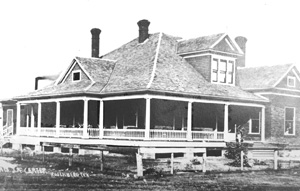A LITTLE PIECE OF HISTORY | By Joan Frances –

This is an early photograph of the Ebell House, located at 812 Second Street. The residence had four chimneys. J.A. Carter built the house in 1901 for his fiancée, Louise Ebell, a pioneer businesswoman in then small town.
The history of Fort Bend County encompasses the people who helped in the development and growth of communities. When the Gulf, Colorado and Santa Fe Railway Companies built passage through Rosenberg, the train depot became the hub of the downtown. A courthouse, post office, mercantile, saloon, bank and restaurants attracted potential residents to move into the area. Many people changed trains in Rosenberg, and they needed a place to stay overnight or during long layovers between trips. In the beginning, people slept in make-shift tents overnight, then insightful city leaders sought to accommodate people traveling through the city. A two-story hotel north of the railroad tracks was built. When John Ebell came to the city around 1880, he decided to build a hotel closer to the depot to provide lodgings to visitors and to entice them to settle in Rosenberg. Ebell built a large one-story frame hotel with a unique office, a large wood fireplace surrounded by comfortable chairs of several designs and oil lamps on brackets and tables. Later, he built several two-room cabins in the yard, each containing a bed, chair, dresser, mirror, bowl and pitcher. John and his wife, Louise, their two children, Annie, born in 1883 and John Oscar, born in 1892, lived in the hotel.
The Ebell Hotel was located about 500 feet west of Union Depot and was connected to the station by a long boardwalk that traversed a pool or pond of water. Mrs. Ebell had a worker named Louie (or L. C.) Kruse who met all the trains, saw to it that each passenger woke up in time for the midnight stops and carried their baggage to the station in a simple luggage cart. When John Ebell died in 1894, Louise met John A. Carter, a contractor and builder. Around 1901, Carter built the widowed Mrs. Ebell a large brick residence at 812 Second Street, near the hotel as a wedding proposal. It was constructed on concrete piers that sunk about 18 feet into the ground and was made of cypress wood. All of the bricks were made on the Brazos River. It was completed sometime after they married.

A dolly that was used to transport luggage from the train station to the hotel and back. The cart is presently in the Fort Bend County Museum’s collection. Photo from Fort Bend History Association.
Louise leased the hotel near the home to Mrs. M. E. Benson. Mrs. Benson continued to take care of visitors at the hotel until around 1912, when unfortunately, the hotel burned down. From 1924 to 1926, John Carter became the eighth Mayor of Rosenberg, and continued his legacy of building Rosenberg to become a thriving, successful city.
After Carter’s death in 1938, Louise rented out rooms in her home and became a pioneer business woman. She was instrumental in accommodating guests during lay-overs from the train or just visiting the city. With the depot across the street from her house, many people stayed there, and she was well-known and respected in the community. Louise Ebell Carter died in 1951, and as one of the first settlers in Rosenberg, will always be remembered for her public service. The history, traditions and home remain. In 2012, Former Rosenberg Mayor Joe Gurecky and Doris, his wife, purchased the Ebell home and renovated it inside and out.
As the first and oldest brick house in all of Rosenberg, the preservation of this turn-of-the century home has enabled residents and tourists to fully appreciate the detailed craftmanship and splendor of years gone by. The venue will be available beginning in August for bridal showers, parties and seasonal events. This restoration project has enhanced the historical and cultural significance of Rosenberg and reminds residents and visitors that the richness of life comes from its history.